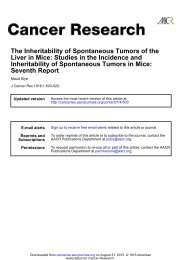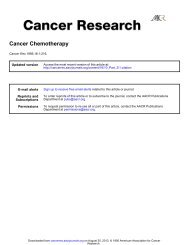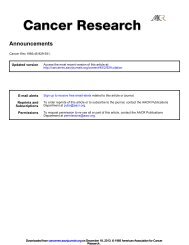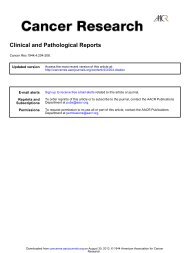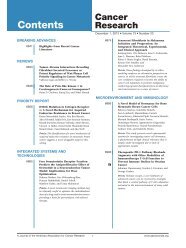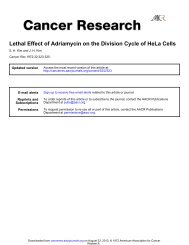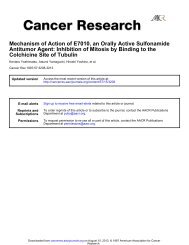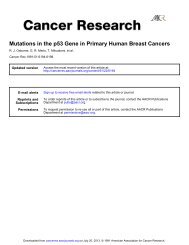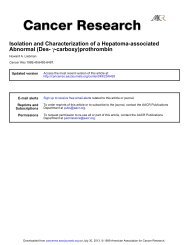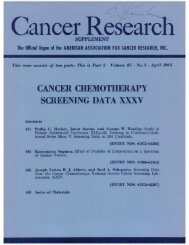Trichothiodystrophy, a Human DNA Repair ... - Cancer Research
Trichothiodystrophy, a Human DNA Repair ... - Cancer Research
Trichothiodystrophy, a Human DNA Repair ... - Cancer Research
You also want an ePaper? Increase the reach of your titles
YUMPU automatically turns print PDFs into web optimized ePapers that Google loves.
esponse curve in Fig. 4B again shows, however, that this failure<br />
to recovery to normal rates is observed only at fluences above<br />
5 J/m2. In contrast in P2 cells a drastic depression of RNA<br />
synthesis is observed after 5 J/m2.<br />
We have also measured cell survival in P3 cells by a procedure<br />
in which nondividing cells are irradiated (27). Dead cells detach<br />
from the dishes after a few days, and the living cells which<br />
continue to adhere are scored. Using this procedure we found<br />
that under these conditions nondividing P3 cells were indeed<br />
more sensitive to the killing action of LJV than were normal<br />
cells (Fig. 8). Note that the lowest UV fluence used in this<br />
procedure is 10 J/m2.<br />
DISCUSSION<br />
The UV responses of our three TTD cell strains are compared<br />
with those of XP and CS strains in Table 4. PI was normal in<br />
all respects whereas the responses of P2 were identical to those<br />
of XP cells from complementation group D. P3 also had a<br />
deficiency in excision-repair which was not complemented by<br />
other excision-deficient TTD cell strains. This deficiency was<br />
less severe than in P2 cells, and dividing P3 cells were not in<br />
fact hypersensitive to either the lethal, mutagenic, or SCEproducing<br />
effects of UV light (Figs. 1 and 2). Our results pose<br />
a number of important questions about the relationship of<br />
defects in <strong>DNA</strong> repair to cell survival, the heterogeneity of the<br />
response of TTD cells, and the relationship between TTD and<br />
XP.<br />
<strong>DNA</strong> <strong>Repair</strong> and Cell Survival: The Anomalous Response of<br />
P3. The cellular responses to UV of P3 are, as far as we are<br />
aware, unique. The molecular defect is not complemented by<br />
other TTD strains, which in turn were not complemented by<br />
0 10 20 30<br />
U.V.DOSE Qrrtf]<br />
Fig. 8. Survival of nondividing cultures. Nondividing cells, maintained for 7<br />
days in medium containing 0.5^'c serum, were UV irradiated with various fluences.<br />
After a further 7 days the cells adhering to the dishes were trypsinized and<br />
counted.<br />
Table 4 Summary of UV responses in TTD cells'<br />
Survival (CFA)Survival<br />
(ND)MutabilitySCEsUDSScintAutoradiographyEq.<br />
<strong>DNA</strong> REPAIR DEFECT IN TRICHOTHIODYSTROPHY<br />
XP-D cell strains (7). The simplest interpretation of these<br />
complementation data is that the TTD and XP-D strains have<br />
defects in the same gene, although this remains unproved, and<br />
other interpretations are possible. The level of UDS in XP-D<br />
cell lines is generally between 10 and 50% of that in normal<br />
cells (14, 16, 28-30), so that P3 is at the higher end of this<br />
spectrum. However, all XP-D strains examined show extreme<br />
hypersensitivity to the lethal effects of UV with D0 values being<br />
between 3- and 10-fold less than that of normal strains (Refs.<br />
30-32 and our own unpublished results). In contrast dividing<br />
P3 cells were not hypersensitive to UV light. We have shown<br />
that the molecular defect in P3 is most marked after high UV<br />
fluences and during the period immediately following irradia<br />
tion. It is possible that sufficient repair occurs at later times to<br />
bring about normal survival, mutability, and SCEs after rela<br />
tively low UV fluences in dividing cells. After high UV fluences<br />
in nondividing cells, however, RNA synthesis fails to recover<br />
and cells are killed.<br />
What is the nature of the deficiency in excision-repair at<br />
early times after UV irradiation of P3 cells? The amount of<br />
repair synthesis measured in experiments such as those shown<br />
in Fig. 3 is the product of the number of repaired sites and the<br />
size of the repaired patch of <strong>DNA</strong> at each site. Decreased repair<br />
synthesis could result either from fewer repaired sites or from<br />
shorter repair patches. We consider that in P3 cells the former<br />
explanation is much more likely since the dose response for<br />
repair synthesis (Fig. 3) is very similar to that for incision<br />
breaks (Fig. 6). The latter parameter is not affected by the size<br />
of the repaired patch. Two excision-repair processes are known<br />
to occur early after UV irradiation. <strong>Repair</strong> of pyrimidine dimers<br />
in actively transcribing regions of <strong>DNA</strong> occurs rapidly (33), and<br />
recent work has shown that CS cells are specifically deficient<br />
in this repair process (34). As shown in Table 4, however, CS<br />
cells differ from P3 cells in having no detectable defect in<br />
overall excision-repair (24) (the defect can be observed only by<br />
studying specific genes) and CS cells are hypersensitive to the<br />
lethal, mutagenic, and SCE-producing effects of UV light.<br />
Excision of 6-4 photoproducts has also been shown to occur<br />
rapidly after irradiation (35), and it is not inconceivable that<br />
P3 cells, like XP cells from various complementation groups<br />
including group D (36), are deficient in removal of these lesions<br />
from cellular <strong>DNA</strong>. Experiments are under way to test this<br />
hypothesis. In the meantime a definitive explanation for the<br />
normal cellular properties of P3 being associated with deficient<br />
excision-repair must await further experimentation.<br />
Heterogeneity of TTD. Although the clinical symptoms of<br />
TTD are diverse, they form a defined syndrome. Our results at<br />
the cellular level emphasize this heterogeneity. At the two<br />
extremes we have PI, which like a TTD cell strain described by<br />
Stefanini et al. (12) has no cellular defect in its responses to<br />
UV light, and P2 and several TTD strains of Stefanini et al. (1)<br />
with extreme hypersensitivity and very defective excision repair<br />
attributable to the "XP-D mutation." In between is P3 with<br />
some defective responses and others normal. It is of interest<br />
that none of our patients exhibited any photosensitivity. In the<br />
Italian patients defective excision-repair correlated with pho<br />
tosensitivity.<br />
Cent.Incision<br />
XP and TTD. An intriguing implication of the findings of<br />
breaksUV<br />
endonucleaseRNA<br />
Stefanini et al. (7, 12) and of those described in this report<br />
synthesisPINNN100100NP2SSSSs1015SSsSSP3NSNN505050SNSSXPDSSSSSSSS10-5010-5010-50SSSSSCSSSSSSSSS100100100NNSS<br />
concerns the relationship between the defect in <strong>DNA</strong> repair<br />
°Data from XP-D and CS strains are from the literature. N. normal; S, and the clinical symptoms of XP and TTD (also discussed in<br />
sensitive or defective; SS, very sensitive or defective. UDS values are expressed<br />
as approximate percentages of values in normal strains. CFA, Colony-forming<br />
ability; ND. Nondividing cells; Scint., scintillation counting: Eq. Cent., equilib<br />
rium centrifugation.<br />
Ref. 10). The extensive literature on XP has established, almost<br />
as a dogma, that a defect in excision-repair is the underlying<br />
cause of most of the skin lesions, especially of the enhanced<br />
6094<br />
Downloaded from<br />
cancerres.aacrjournals.org on August 13, 2013. © 1988 American Association for <strong>Cancer</strong><br />
<strong>Research</strong>.




